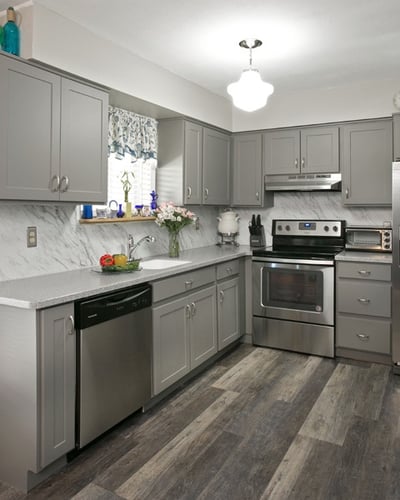Cork flooring offers unique advantages for kitchens, starting with its exceptional comfort underfoot. The natural cushioning reduces fatigue during long cooking sessions, making it easier on joints than harder surfaces like tile. Its cellular structure provides built-in insulation, keeping floors warmer in winter and reducing noise from dropped utensils. Cork’s natural elasticity allows it to bounce back from minor dents caused by heavy appliances or foot traffic. Environmentally conscious homeowners appreciate that it comes from renewable bark harvests without harming cork oak trees. These qualities make it a thoughtful choice for busy kitchens where comfort and sustainability matter.
Maintenance and durability present some considerations with cork floors. While pre-finished cork resists stains, it requires regular sealing to maintain water resistance in spill-prone kitchens. Minor scratches can be concealed with light sanding and fresh sealant, but heavy abuse may require professional refinishing. The soft surface shows wear patterns in high-traffic areas over time, especially under table chairs or islands. However, quality cork flooring with durable finishes can last 10-15 years with proper care. Its antimicrobial properties naturally inhibit mold and mildew growth, an advantage in humid kitchen environments where moisture accumulates.
Installation factors significantly impact cork flooring performance. Floating cork planks simplify DIY installation with click-lock systems that accommodate minor subfloor imperfections. Glue-down tiles provide greater stability for heavy kitchen appliances but require more skill to install properly. Cork expands and contracts with humidity changes, necessitating expansion gaps around perimeter walls. Professional installation ensures proper sealing of edges and seams—critical areas where water infiltration could cause damage. Unlike some flooring types, cork can be installed over radiant heating systems, adding comfort in colder climates without compromising the material’s integrity.
Cost comparisons reveal cork’s middle-ground position among kitchen flooring options. Prices typically fall between budget vinyl and premium hardwood, making it accessible for mid-range kitchen remodels. While the upfront cost exceeds some materials, its insulation properties may reduce heating bills over time. The need for periodic resealing adds to long-term maintenance costs that harder surfaces don’t require. However, cork’s durability-to-price ratio compares favorably when considering its comfort benefits and acoustic advantages in open-concept homes where kitchen noise carries.
Aesthetic flexibility makes cork adaptable to various kitchen styles. Modern manufacturing techniques produce cork in colors ranging from natural honey tones to contemporary grays, with options mimicking wood or stone textures. Its uniform appearance suits minimalist designs, while varied grain patterns add organic character to rustic kitchens. Cork’s matte finish provides subtle visual warmth that complements both traditional cabinetry and sleek modern designs. Unlike cold tile, it creates an inviting atmosphere where family naturally gathers. While not indestructible, proper product selection and maintenance make cork a viable, comfortable option for kitchens where comfort and eco-friendliness take priority over absolute durability.
Cork Flooring—Advantages and Disadvantages
Flooring Tips – Page 7 of 9 – Alliance Flooring Directory
All About Hardwood Floors Easy kitchen upgrade, Cork flooring, Kitchen flooring
Pros & Cons of Hardwood Flooring in the Kitchen
Related Posts:

/182177160-56a2fd883df78cf7727b6d11.jpg)

/9-56a2fc2b3df78cf7727b6831.jpg)


